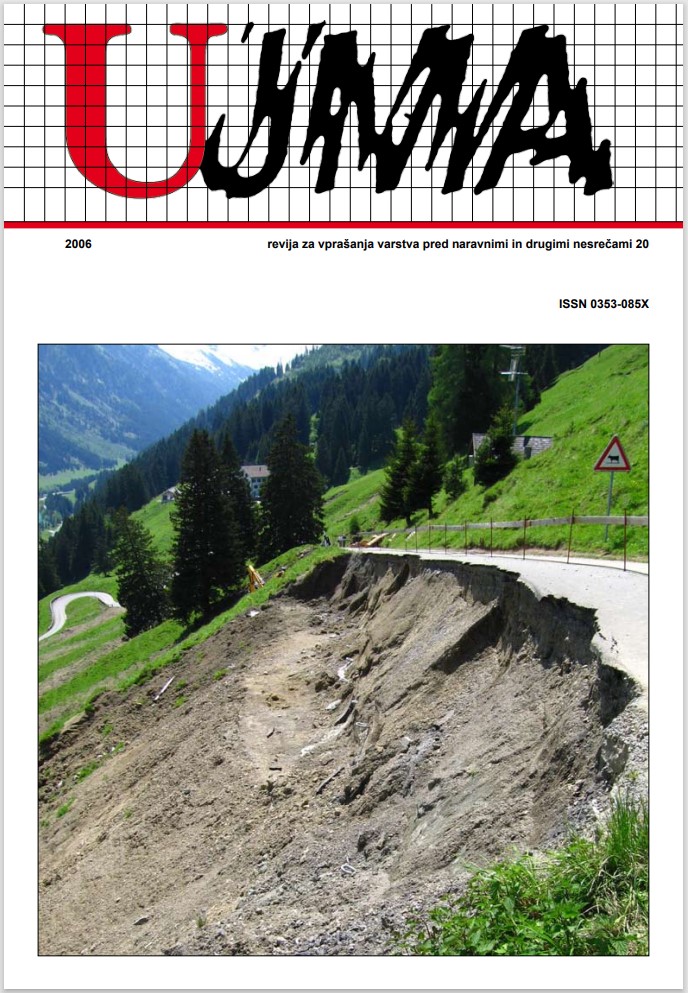TOXIC CYANOBACTERIA: POPULATION AGAINST WATER – A MUTUAL THREAT
Abstract
Bloom forming toxic cyanobacterial genera and their cianotoxins are present in the majority of surface water bodies in the Republic of Slovenia. These water bodies represent a permanent threat to human and environmental health, since they accumulate substances that are highly toxic to both animal and plant species. Endangered areas and the expected groups of toxins originating from cyanobacteria are described. Special emphasis is given to inappropriate management of surface water bodies, which leads to increased eutrophication. EU legislation devotes particular attention to harmful blooms, since they are responsible for substantial economic losses. Surface waters with high cyanobacterial counts are unsuitable even for industrial purposes. Identification of this natural phenomenon is of significant importance for both civilians and the armed forces. Waters with a highly toxic cyanobacterial content are not merely a risk to public health and an ecological threat, but can also be as biological weapons.
References
Bricelj, M., Sedmak, B., 2001. Transport of biologically active substances through gravel strata. V: Seiler, K-P (ur.), Wohnlich, S (ur.). New approaches characterizing groundwater flow: Proceedings of the XXXI International Association of hydrogeologists Congress, Munich, Germany, BalkemA, 25–29.
Chorus, I., Bartram, J., 1999. Toxic cyanobacteria in water: A guide to their public health consequences, monitoring and management. World Health Organization, E&FN Spon, Routledge, London, pp. 416.
Codd, G., A., Bell, S., G., Brooks, W., P., 1989. Cyanobacterial toxins in water. Water Sci. Technol. 21: 1–13.
Codd, G., A., Azevedo, S., M., F., O., in sod., 2005. CYANONET A global network for cyanobacterial bloom and toxin risk management. Initial situation assessment and recommendations. IHP-VI, Technical documents in hydrology, No. 76, UNESCO, Paris, pp. 138.
Francis, G., 1878. Poisonous Australian lake. Nature 18: 11–12.
Jochimsen, E., M., Carmichael, W., W. in sod., 1998. Liver failure and death after exposure to microcystins at a hemodialysis center in Brazil. New England J. Med. 338: 873–878.
Kolar, B., Štajnbaher, D., Babič, M., Sedmak, B., Kosi, G., Povž, M., 1995. Pojavljanje strupenih cianobakterij in poginjanje rib v ponikovalnikih v Hotinji vasi. Maribor: ZZV.
Sedmak, B., Kosi, G., 1991. Alge i njihovi toksini u našim vodama. (Povodom masovne pojave modrozelenih algi Aphanizomenon flos-aquae u Bledskom jezeru). Vodoprivreda 23: 265–272 (English abstract).
Sedmak, B., Kosi, G., Kolar, B. 1994. Cyanobacteria and their relevance. Period. Biol. 96: 428–430.
Sedmak, B., Kosi, G., 1997a. Cvetenje cianobakterij v ribnikih Republike Slovenije in njihova toksičnost. Ichthyos 14: 9–21 (English abstract).
Sedmak, B., Kosi, G., 1997b. Microcystins in Slovene freshwaters (Central Europe) – First report. Nat. Toxins 5: 64–73.
Sedmak, B., Kosi, G., 2002. Harmful cyanobacterial blooms in Slovenia – Bloom types and microcystin producers. Acta Biol. Slovenica 45: 17–30.
Teixera, M., G., L., C., Costa, M., N., C., Carvalho, V., L., P., Hage, E., 1993. Gastroenteritis epidemic in the area of the Itaparica Dam, Bahia, Brazil. Bull. Pan. Am. Health Org. 27: 244:253.
Turner, P., C., Gammie, A., J., Hollinrake, K., Codd, G., A., 1990. Pneumonia associated with cyanobacteria. Brit. Med. J. 300: 1440–1441.
Vrhovšek, D., Kosi, G., Jošt, K., Bukanovski, A., 1981. Limnološka istraživanja na akumulacijama u okolini Celje (Šmartinsko jezero i Slivniško jezero). Ekologija, (Acta biologica Iugoslavica) 16: 141–165.
WHO, 2003. Guidelines for safe recreational water environments. Volume 1: Coastal and fresh waters, World Health Organization, Geneva, pp. 219.
Downloads
Published
Issue
Section
License

This work is licensed under a Creative Commons Attribution-NonCommercial-NoDerivatives 4.0 International License.
The articles are made available to the public under Creative Commons Attribution-NonCommercial-NoDerivatives 4.0 International (CC BY-NC-ND 4.0).


